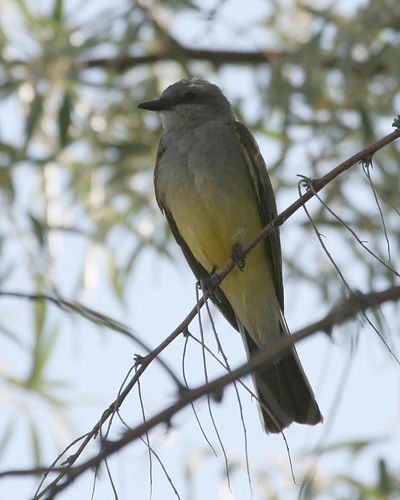After I left the Bear River Migratory Bird Refuge visitor center, it was a drive of several miles before I got to the actual refuge. The drive was along a quiet country road, and I stopped several times to bird the fields along this road. One of the species I saw several times was Western Kingbird. Since I had not done very much research on the birds I might see, however, I was a bit surprised to also see just as many Eastern Kingbirds.
There are several "eastern/western" species pairs that come to mind as I write this: Meadowlark, Wood-Pewee and Kingbird. For the Meadowlark and Wood-Pewee species pairs, I think the eastern variety looks very similar to the western variety, so understanding song, habitat, behavior or range differences helps me understand which one I am observing. But the differences between an Eastern Kingbird and a Western Kingbird are much more obvious to me. My challenge was not understanding that I had something other than Eastern Kingbird, but understanding which of the other U.S. Kingbird species I was observing (Tropical, Couch's, Cassin's, Thick-billed, or even Gray).
I am used to the Eastern Kingbird: white underparts; black or dark gray head, back, wings and tail; white edge at the end of the tail; and a song that sounds like electricity buzzing. When I saw one of them on my drive to the refuge, I knew it immediately. I did not realize that I had it so easy, however, when dealing with Eastern Kingbirds back home. Of all of the Kingbird species that occur in the U.S., the Eastern's appearance is fairly unique. I guess that is not entirely true, since the Gray Kingbird is moderately close in appearance to an Eastern. But since you will probably need to be in south Florida in order to see a Gray, I quickly ruled it out as an option.
So that left five more Kingbird choices, and to my inexperienced eyes they look fairly similar to each other. All but one of them, however, could be ruled out for much the same reason as Gray: it would very unlikely to see them in Northern Utah. Even better, the bird I was observing had white edges down the sides of its tail. So, being in Northern Utah, and looking at a Kingbird with white edges down the sides of his tail, told me that this was a Western Kingbird and not one of the others.
Here are my photos. The first is a Western Kingbird. He was perched under the shady canopy of a tree. The second is an Eastern Kingbird. He was perched on a wire fence next to the road.


No comments:
Post a Comment